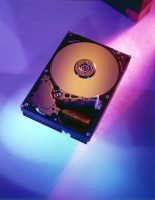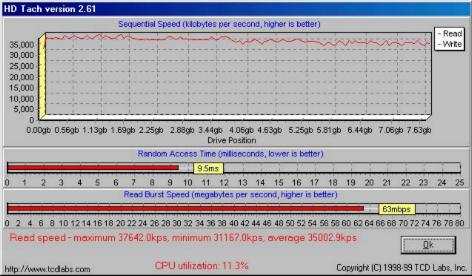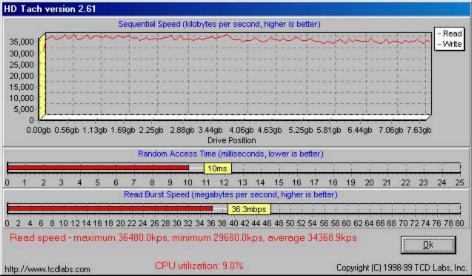IBM GXP 75
In the last year or so we have been spoilt with very high CPU MHz speeds, high quality 3D graphic cards and high speed CD/DVD rom’s. Now this is all very well and good but what is the point of having all this latest hi-speed computer equipment and then chucking in a Dog-slow Hard drive, which keeps the CPU waiting whilst the hard drive is slowly supplying it data. We have seen in the recent years the IDE bus speeds increase from UDMA33 to UDMA 100 and this is always plastered in computer adverts, but to the average computer user is very misleading.
So many
high performance P.Cs are sold on having UDMA66/100 IDE controllers which allow
up to 66/100 Megabytes a second Data transfer, but the hard drives fitted in the
machine (Generally just the capacity being advertised), whilst having a
UDMA33/66/100 interface can only supply data at a sustained rate or 8-17
megabytes a second which is way below what the IDE interface can actually handle
even on the now outdated UDMA33 interface. What we need is a Hard Drive that can
actually supply data to the CPU at a very higher speed, thus keeping up on the
benefits of high MHz Cpu’s etc.
This is where the latest offering from IBM comes very welcome. Introducing the IBM DESKSTAR GXP75 7,200 RPM Hard Drive

Specification
Highlights.
The IBM
Deskstar 75GXP combines industry-leading performance at 7200 RPM with internal
transfer rates of 444 Mbits/sec and average seek times of 8.5 ms to enable a
sustained data transfer rate of up to 37 MB/sec. Capacities range from 75 to 15
GB.
-
Large 2MB Buffer
-
A safety ramp feature virtually eliminates damage to the data area caused by drive mishandling before installation.
-
A thermal monitor protects data writes/reads over the full system temperature range.
-
Tagged command queuing and hardware caching boost sustained data rates to reduce wait times.
-
An ATA-compatible drive interface enables data transfers to 100 MB/sec.
This range of
IBM drives is the first to use glass disk platters instead of aluminum. The
smoother and more rigid glass disks allow the recording head to read smaller
bits of information that are packed more closely together. In addition glass
disks are more stable at higher speeds.
In addition
these drives are equipped with IBM’s load/unload technology. This feature
parks the heads of the disk surface when not in use, dramatically increasing the
amount of shock the drive can handle.
Other technology that’s enhanced the drives performances include a faster processor (100MHz MPU, Clock rate doubled), more advanced LSI chips and improved hardware caching. Basically IBM have dramatically raised the performance of this drive compared to its last offering, which at that was a very fast drive. I could go on and on with more improved features but its time to see what this Baby can actually do!
Test Setup
-
Globalwin 802 case & 300w Power supply
-
Abit KT7-Raid UDMA100 Motherboard
-
Amd Thunderbird 1,000 MHz Cpu
-
256Mb Crucial PC133 Cas2 Dram
-
Elsa Ge-force 2 GTS 32MB Graphics card
-
Creative SoundBlaster 1024 Sound Card
-
Acer 50x CDRom UDMA33
-
Creative 8/4 CDRW IDE
-
Iiyama 21” PRO502 Monitor
Benchmarking Programs
CDPRO HD TACH Version 2.61
SiSoft SANDRA Millenium
Benchmark Result
This is with the drive attached to the UDMA100 interface via 80 pin UDMA66/100 cable.
HD Tach UDMA 100

This shows that this drive can supply data at a very high average rate of over 35 Mega Bytes a second which is nearly twice that of IBM’s last 7,200 rpm drive the GXP34 range.
SI Soft UDMA 100

These results speak for themselves. A huge score of 23137 compared to that of 13000 scored by most UDMA66 7,200 rpm hard drives.
For those people out there with motherboards that only support UDMA66, I attached the drive to this interface to see if there was any performance drop. Here are the results.
HD Tach
UDMA 66

SSOFT UDMA66.

As you can see there has a very slight performance drop when using these UDMA100 drives on a UDMA66 interface. As I stated before the speed of the IDE interface has been outgrowing the actual speed that’s the hard disks can supply the data, but this gap has now been tightened.
So now we have seen the performance figures you are probably wondering…How does this make the computer feel, Well all I can say is WOW! When clicking on a word file ,Microsoft Office is opened and the document loaded at the blink of an eye and the whole feel of the computer is so slick. No more waiting seconds for a window to open, click and its there!!!!
Now having an Abit KT7-Raid Motherboard, and more and more users are interested in this technology, I just had to set up a Raid 0 array to see how stupidly fast scores I could get. For those who don’t know much about RAID technology, Raid 0 uses two hard drives of the same capacity but stores half the data on one disk drive and half on the other and when you access this data, you are reading 50% from one drive and 50% from the other at the same time, thus theoretically increasing transfer times by 100%.
Here are the results.


In HDTACH this scored an amazing 69.8 Megabyte a second average transfer rate and in Sisoft scored an amazing 45,370 which is basically double compared to using a single drive. Obviously the fact that you need 2 hard drives to get this extremely fast performance is costly, for those people out there who want the fastest P.C around this is a definite yum yum!!
Conclusion
As far As I
am concerned this is the fastest IDE Drive that I have ever seen, If you are
building a new P.C definitely consider including one of these drives in it. The
cost is slightly above that of other manufacturers 7,200 rpm drives, but
considering the huge increase in performance, I wouldn’t fit anything else.
As all IBM GXP75 hard drives are covered by their 3-Year warranty and due
to their new load/unload technology are very sturdy, considering all these
factors I feel I must award IBM’s GXP75 Hard Drive with an Overall Score of
10/10. Well Done IBM.













